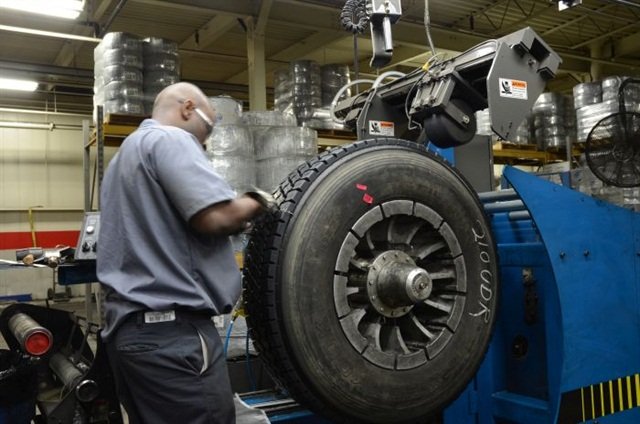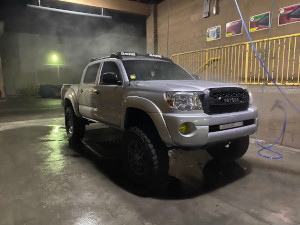Never choose the wrong commercial truck tires again
Tires are the literal wheelhouse of your fleet. Without the right commercial tires, your equipment can cost your company more money and headache than you ever anticipated. We offer the industry’s top selection of commercial truck tire options. Find out how we can help you when choosing commercial truck tires, whether you need to outfit one truck or a nationwide fleet.
Importance of Truck Tires
As the primary point of contact with every paid mile of freight for your company, tires are a huge deal. A truck tire blowout is terrifying and can lead to a serious truck accident. Making sure you choose the highest quality of truck tires helps reduce overall operational cost.
Along with cutting down on braking time, a good set of truck tires will keep your trucks upright and moving down the road with minimal interference. The best brands of commercial truck tires on the market include Bridgestone and Michelin but are not limited to these manufacturers.
Selecting Tires for Workloads
The best tire for one of your work trucks might not be the right solution for your entire commercial fleet. Tire selection depends on a variety of factors including the typical terrain, weather conditions, cargo capacity and vehicle type.
For example, truck driving teams that frequently pass through wintry northern states with oversized freight will want to look into steer tires. This type of commercial tires provides drivers with extra control in wet and icy conditions.
What to Avoid in Tires
What about buying used truck tires that have been retreaded to get more mileage out of the already worn treads? We have all heard of purchasing retreaded tires for commercial trucks.
However, this is a dangerous practice that can leave the driver with new tread peeling on the highway. Using retreaded tires can lead to issues with your insurance company, as well as lawsuits if your drivers are involved in trucking accidents due to retreaded tires.
Benefits of Truck Tire Maintenance
Instead, go with the highest-quality new commercial truck tires for your fleet. Along with choosing the right tire, you also want to establish a truck maintenance service for your trucks. Truck maintenance covers tire wear and tear, as well as any repairs that are needed during deliveries.

FACTORS TO CONSIDER WHEN BUYING TRUCK TIRES
When preparing to invest in new tires, make it a point to consider how much money you will spend during a tire’s whole useable life, not just how much the tire costs initially. Here are four things to keep in mind when considering that new tire purchase.
- Buy tires from someone who cares. Consult with your local Goodyear Commercial Tire & Service Center. The professionals there can evaluate your truck’s needs and make appropriate tire recommendations.
- Cheaper is not always better. Look for tires with premium casings that can be retreaded more frequently, which can allow you to help optimize your initial tire investment.
- Consider retreading. Goodyear offers retreads that match the tread designs of new tires in order to provide premium performance and appearance. For more info about retreading, consult your nearest Goodyear Commercial Tire & Service Center.
- Take good care of your tires. Establish a comprehensive maintenance program for your tires that incorporates inflation checks, alignments and other functions.
Also, make sure you maintain truck suspension and steering system components. Worn shocks, bearings and tie rod ends can contribute to faster tire wear.

The Pros and Cons of Having a Lift Kit
If you have ever ridden around in a truck that is extremely high off the ground, you know the feeling of ultimate power you get from looking down at the cars on the road. Body lift kits are designed to lift your truck or SUV two or three inches higher by putting a high grade nylon spacer between the body and the frame. Suspension lift kits are made to lift trucks as high as the owners will let them. But what are the downsides to putting a lift kit on? Do the kits change the vehicle? Let’s go over the pros and cons of lifting your truck or SUV.
Pros of Body Lift Kits
Lift kits are specially made not to change the quality of how your truck rides. Most lift kits are not too expensive and they are more economical than suspension lifts. Because the shocks are not touched during the lift, new shocks are not required for lift kits. For people who like to go “off road,” lift kits will give your tires more clearance while still retaining the factory suspension geometry and alignment.
Pros of Suspension Lift Kits
Although body lift kits can only be moved one to three inches higher, suspension lift kits can go as high as the driver feels comfortable. This lift allows the owner to purchase bigger tires if they desire. This lift also makes the suspension more articulate.
Cons of Suspension Lift Kits
The annoyance factor can no be overlooked here. It can get annoying climbing in and out of a beast of a truck so before choosing a monster truck, try to picture yourself and your family climbing in and out of it. This lift comes with some maintenance. The supporting pieces may need to be replaced every so often so make sure you are prepared for the costs involved. These kits are also more expensive overall because of the customization done to them. It can void some warranties on your truck or SUV and you will not have a ride as smooth as one without a lift or with a body lift.
Body lift kits are good if you do not want your truck or SUV to perform differently. The quality of the drive remains the same when these lifts are involved. If you want a kit that will raise your truck only a few inches without being a problem, this is the kit for you! If you are looking for that monster truck feeling, the suspension lift kits are for you. Your truck can be raised as high as your budget will allow but be prepared for quite a bit of upkeep as well as having a stepladder in your
Cons of Body Lift Kits
Lift kit installations are more time consuming because of the nature of the job. These kits require the body to be lifted and bolted back into place. A big downside of the lift kit is that the frame is more visible than it was before and gaps can be seen in the fender wells. Unfortunately, due to placement of the body, factory bumpers are not raised with the body. A common complaint with lift kits are the frame visibility. This could be taken care of by gap guards place on the frame. This type of lift does not offer any performance advantages and can hinder the performance because of the new center of gravity.

4 Inch vs. 6 Inch Lift Kit
Any lift kit turns a truck into a piece of beauty – the only issue here is that there are a lot of them out there to choose from, and that my friends makes the whole selection process fairly complicated.
On this post i will be talking about probably the most common, i.e. 4 and 6 inch kits, and guide you through on what to actually go for, from my perspective.
4 inch pros
Fits in more spots
Because the pickup isn’t lifted as high, you will be able to access more places. By that i mean garages, parking spots, car washes, etc.
This may sound stupid at first, though i can tell you that there are a ton of people who go exactly for the shorter lift because of this reason – think about it, if the thing can’t fit in the garage, where are you going to put it?
Ease of use
It’s going to take less effort to access a pickup truck that is lifted only by 4 inches, literally.
Again, this might sound weird at first, but if you’re going to be getting in and out of the cab or the bed all the time, you’re going to thank me that you went this route.
Less severe on the fuel consumption
Now i know that truck owners, especially those who already think of lifting one, probably aren’t really concerned about this, but still.
A 6 inch lift kit would require larger tires than a 4 to make the whole deal look proper, and as we all know, the bigger the tire the more power needs to be generated in order to drive it, hence the decrease in fuel economy.
Generally less expensive
The cost comes from the fact that the pickup won’t need to sport larger tires, that is, a 33 inch tire will definitely be a bit more affordable than the 35’s.
6 inch pros
More off-road
A vehicle raised by 6 inches instead of 4 inches will sit on a higher level, therefore be able to perform better in not-so-favorable conditions, even more so if it’ll have taller tires installed.
What should i go for then?
The only reason why a 6 inch lift kit would be a smarter choice is if you really need to hit the off-road, if you ask me.
The 4 inch lift provides just enough raise to make the truck look far better than a stock, and still provide it with enough benefits that come from increased level of clearance. This pick makes only more sense if your truck is also a 2WD.
If you really can’t decide between the two, what you can try is literally test drive pickup trucks that feature both types of the suspensions kits. After it, you might end up going for the entirely different route than you thought of first.